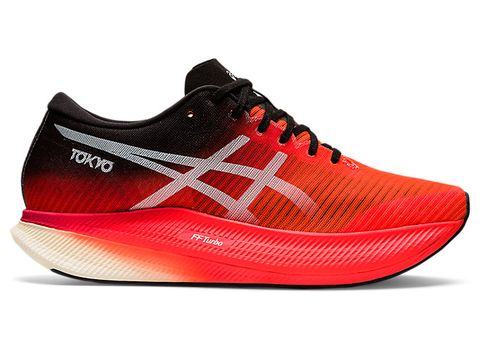
It’s a well-known equation in running that speed = stride x cadence. That is to say, the length of each stride multiplied by the number of strides you take per minute.
Asics has spent some time making these factors the centre of its R&D and the result is the release of two new models: the Metaspeed Sky (available now) and the Metaspeed Edge (available from June 4).
The brand’s theory is this: Not all runners try to increase their speed the same way, so why should they all wear the same shoe?

Lab tests at Asics’s HQ in Kobe, Japan, showed that some runners increase their speed by lengthening their stride (‘a long, loping gait with large periods spent airborne’ says the brand—think Mo Farah coming down the home straight on the track), while others speed up by increasing both their stride length and the number of strides they take (‘smaller steps while hovering over the ground with minimal up-and-down motion’—think most of the rest of us).

The Metaspeed Sky is for the former group (‘Stride’ runners) and the Metaspeed Edge for the latter (‘Cadence’ runners).
Here’s what both shoes have in common:
And the differences: Asics’s tests showed that ‘Stride’ runners require a greater vertical rebound from the midsole to extend their stride, so the Sky has a chunkier midsole of 33mm in the heel and 28mm in the forefoot to give extra bounce, compared with 29mm and 21mm for the Edge.
The lower drop on the Sky (5mm) coupled with a more pronounced toe spring allows the foot to transition more quickly through the gait cycle and up through toe-off.

According to Asics, ‘Cadence’ runners need more control of force from footstrike to toe-off, which is why it has the higher heel drop of 8mm, to give a greater sense of stability and control.
Incidentally, the Metaspeed Sky is the shoe Beth Potter was wearing when she ran the second-fastest road 5K ever on Easter Saturday .
There’s a lot to unpack here and with the shoe being ambitiously priced at $250 to match the claims the brand makes (among them: over the course of a marathon the Sky improves your running economy by 3 per cent, while the Edge will reduce the number of steps you make during those 26.2 miles by 2.6 per cent).
Source: Read Full Article